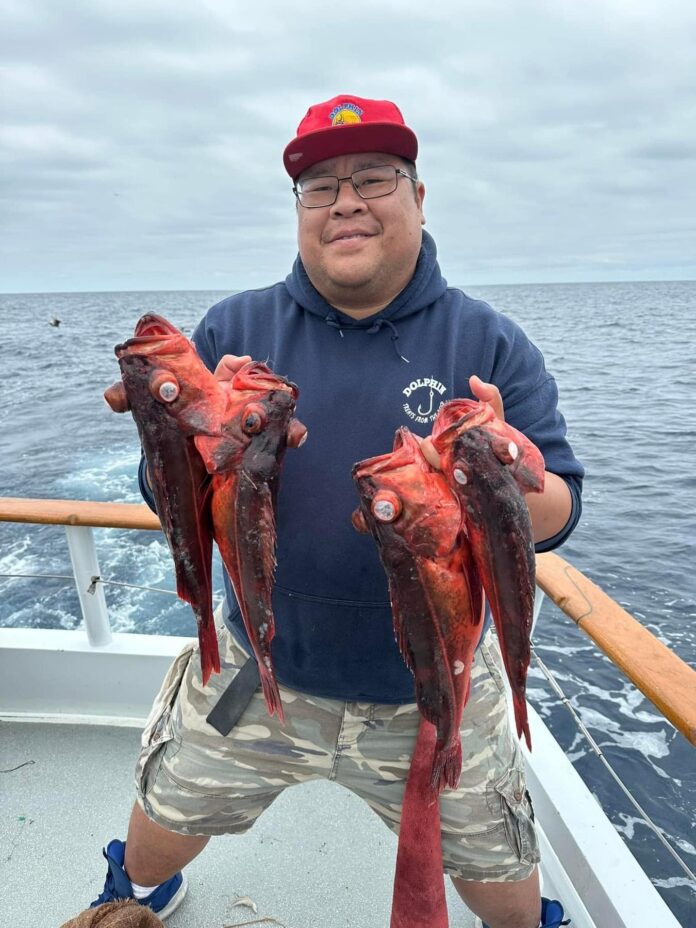
BY Merit McCrea
SACRAMENTO – October 1 the rockfish seasons flopped from shallow only to deep only, just in time for fall’s flat weather days. The CDFW posted the following:
“Throughout the month of October, boat-based anglers who are targeting rockfish, cabezon and greenling species or lingcod may only fish in waters seaward of the 50-fathom Rockfish Conservation Area boundary line. Only shelf rockfish, slope rockfish and lingcod may be retained, while take and possession of nearshore rockfish, cabezon and greenling are prohibited during the offshore only fishery.
“This offshore only fishery will remain in effect through the end of the year for anyone south of 36°00′ N latitude (near Point Lopez, Monterey County). However, for those who fish north of 36°00′ N latitude you will have one more opportunity to fish inshore of the 20-fathom boundary line during the month of November, before it moves back offshore December 1, through the end of the year.
“This seasonal change does not apply to divers and shore-based anglers, who will continue to be exempt from boat-based season restrictions affecting rockfish and other federally managed groundfish. As a reminder, in waters where groundfish species or species groups are closed, such as the Rockfish Conservation Areas, boat-based anglers may possess groundfish to anchor, drift, or transit in or through that closed area. Additionally, while anchoring, drifting or transiting through a closed area with groundfish aboard, anglers may only deploy gear specific to the take of crustaceans, including hoop nets, Dungeness crab traps and dip nets.”
What the transit rules allow is hoop netting for lobster and crabs, and where otherwise legal, the use of pots/traps for lobster and using a “hand-held dipnet” for squid and other species allowed to be taken with a scoop or hand net.
The key here is once you have rockfish or lingcod on board you may not have hook and line gear in the water at all when you are in waters those fish can’t legally be taken. But you can now stop and anchor and fish other gears for crabs, lobster and squid. This was not legal in closed waters until this year.
The reason for the closed waters between 20 and 50 fathoms is to avoid quillback rockfish. Limitations in deep water time reflect the need to keep vermilion catches down so that season lengths could be longer. Longer seasons provide greater access to the other rockfish species. It is also important to spread fishing pressure out as broadly as possible within the available open waters without taking too many of the “constraining species.”
All the closed areas, despite the named depth, are on the basis of point-to-point lines. The 20-fathom lines are in state regulations and only in state waters. This means during the November inshore-only season that happens north of Point Lopez, all Federal waters are closed to bottom fishing during November, even those shallower that 20 fathoms or 120 feet .
The State-Federal boundary is at 3 nautical miles from land except where it goes out in deeper waters straight across Monterey Bay.
The 50-fathom lines are all in Federal waters. The rule talks about “offshore” or “seaward” of the lines. You need to be farther from land than that line. There are only two exceptions where the lines are drawn around offshore high spots – the Cortes and Tanner banks.
All other offshore highspots that aren’t otherwise closed (Cordell, MPAs, the 8 Groundfish Exclusion Areas or GEAs far offshore in SoCal) will be open during the offshore-only season.
This means the Osborn Bank outside of the MPA at Santa Barbara Island will be open. However, unlike the inshore season when the deeper water “slope” and “shelf” rockfish were legal to have so long as you caught them in shallow waters – for example reds, during the offshore-only season the “nearshore” rockfish species won’t be legal to have at all.
“Nearshore Rockfish: (§1.91(a)(1) black, black and yellow, blue, brown, calico, China, copper, gopher, grass, kelp, and olive rockfishes; treefish Cabezon and Greenlings (§28.28 and §28.29)”
The most challenging of these will be the olive rockfish because it is often considered the same as yellowtail rockfish, as many people lump them together calling them “Johnny bass.”
During the offshore season yellowtail rockfish are keepers while olives are illegal to have. If you look closely at the scales, yellowtail have brown flecks at the back edge of each scale. Olives don’t.
There are other differences of course and once you’ve seen a few of each you can spot the difference in seconds from across the deck – subtly different body and head shape, fin and body color.
Here’s a very helpful web addresses:
https://wildlife.ca.gov/Fishing/Ocean/Regulations/Groundfish-Summary
Once there you can find links to the boundary line coordinates, rockfish ID pictures, prohibited species, all closed areas and their coordinates.
But the bottom line for boat-based anglers is go with an experienced skipper who knows their stuff including the rockfish regulations. If you want to be that guy though, dig in, get the numbers and put them in your plotter.
If you are a tech geographer, know that with a little digging you can find pre-built shapes for all as shape-files and kml/kmz and other formats within the CDFWs online resources. This writer loads kml files into Google Earth, builds regional sets and copies them out for use on a tablet or cell phone. They can be opened in apps like MAPinr for use offshore.

THIS COMPACT REGS TABLE won’t pass ADA requirements for state agencies but it does offer the full suite in a very compact format. IMAGE FROM PFMC BRIEFING BOOK FILES



